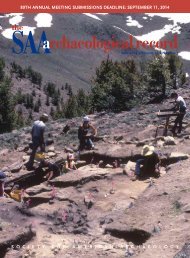SAA
Nov2016_web
Nov2016_web
You also want an ePaper? Increase the reach of your titles
YUMPU automatically turns print PDFs into web optimized ePapers that Google loves.
VIDEO GAMES AND ARCHAEOLOGY<br />
VIDEO GAMES AND ARCHAEOLOGY<br />
Colleen Morgan<br />
Colleen Morgan is the Centre for Digital Heritage Postdoctoral Fellow in the Department of Archaeology at the University of York.<br />
Introduction to the Theme “Video Games and<br />
Archaeology”<br />
Video games are a growing concern in academic research and<br />
present a considerable attraction for archaeologists who wish<br />
to present their research in a media format that can incorporate<br />
multiple perspectives, alternate narratives, and 3D representation<br />
to audiences that may not be engaged with other<br />
forms of academic literature or media regarding archaeology.<br />
Since Watrall’s (2002) formative article in the <strong>SAA</strong> Archaeological<br />
Record and Public Archaeology, experimentation with gaming<br />
and archaeology has expanded considerably. The diversity<br />
of the articles featured in this dedicated issue reflects this<br />
growth.<br />
Much of the research on video games and archaeology and<br />
heritage incorporates what could be characterized as “media<br />
archaeology.” Though media archaeologies are usually<br />
within a Foucauldian discourse that draws on tropes of<br />
archaeology without engaging with archaeological method or<br />
theory, it has recently been the topic of interdisciplinary work<br />
in contemporary archaeology. Archaeologists, it has been<br />
argued, are the prototypical media archaeologists, “studying<br />
media (in their broad conception, as discursive and material<br />
means to a plurality of different ends/processes), inventing<br />
and tinkering with media to progress such studies, and skilfully<br />
deploying other media to circulate this work” (Perry and<br />
Morgan 2015). Archaeologists who study video games illustrate<br />
the energy and creative potential within this interdisciplinary<br />
space, with research that investigates the history and<br />
materiality of archaeological games as artifacts, including<br />
the literal excavation of video game cartridges and other<br />
gaming material culture, the critique of archaeological content<br />
in video games, the use of gaming strategies to query<br />
past landscapes, collaboration with gaming studios and<br />
gamers to create archaeology-based games, and the creation<br />
of video games by archaeologists.<br />
The authors in this issue show the nuance of video game<br />
research in archaeology through particular case studies. This<br />
collection also reveals a community of practice deeply<br />
involved in digital-making and participatory research, known<br />
in part under the #archaeogaming hashtag on Twitter and<br />
through blogs such as Play the Past. As the VALUE Project<br />
demonstrates in their article, many academic archaeologists<br />
play video games, though few connect them to their<br />
research. At Leiden University, 69 percent of undergraduate<br />
students, graduate students, and staff members play video<br />
games, yet many who responded to their essay felt that “real<br />
archaeology” is not exciting enough for games. Further,<br />
Graham notes that many colleagues do not find video games<br />
worthy of academic study, despite their obvious financial and<br />
cultural impact and the emerging complementary field of<br />
game studies. That there is controversy is surprising, considering<br />
archaeology’s early forays into and continuing engagement<br />
with virtual reality for producing archaeological<br />
reconstructions. Champion also notes considerable opposition<br />
to academic engagement with games but argues that virtual<br />
heritage projects and serious games have in fact failed,<br />
and that archaeologists should instead focus on the expected<br />
audience for digital media. He mentions a new UNESCO<br />
Chair of Cultural Heritage and Visualisation that will build a<br />
repository of 3D heritage models to improve public accessibility.<br />
This effort toward the curation and preservation of 3D<br />
models speaks to a growing awareness of digital materiality<br />
within archaeology and heritage.<br />
Video games provide landscapes and objects that are productive<br />
for archaeological investigations of digital materiality.<br />
Reinhard explores the tools that can be used to “excavate”<br />
video games and suggests adapting GIS for survey and<br />
analysis in virtual spaces. He is leading a group of archaeologists<br />
exploring No Man’s Sky, a procedural video game in<br />
which landscapes, creatures, and objects are created by algorithms<br />
rather than manually. This builds on Graham’s suggestion<br />
of a link between landscape archaeology and the<br />
November 2016 • The <strong>SAA</strong> Archaeological Record<br />
9




